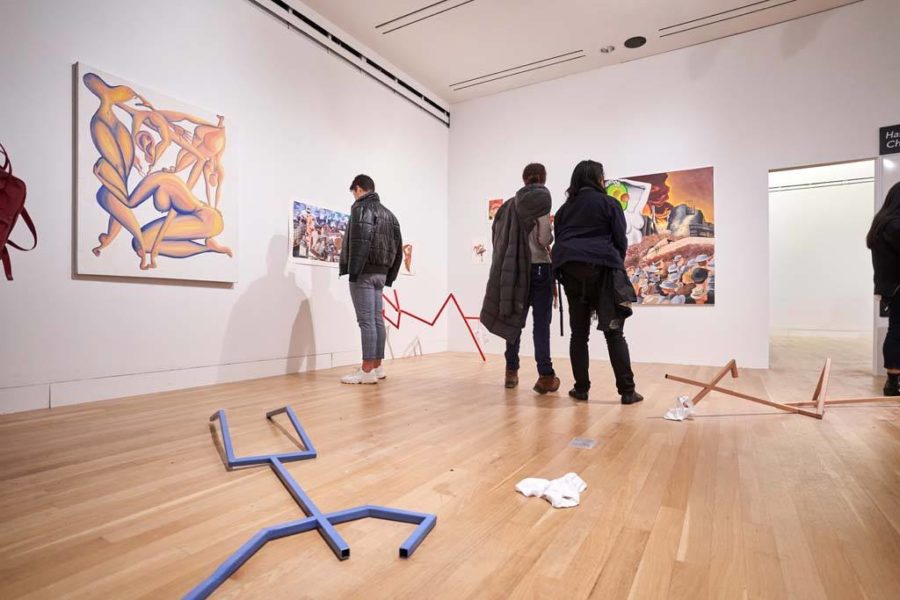The title of this year’s B.A. exhibition, for an easier recipe, sear pork shoulder, is an excerpt from an elaborate recipe sent to the exhibition group chat in error. The message implores the usage of “marinara (high quality)” and advocates for a specific type of saltwater duck. The show’s artwork, like its title, displays a similar mixture of meticulous attention to detail as well as a surreal sense of humor—“^sorry guys wrong chat,” reads the exhibition program.
Every detail in Michael Zhu’s works, for example, seems to carry symbolic significance, from the backward lettering scattered throughout his works to the subtle staircase that appears in the background of two of his paintings. Jeffrey Hsu’s Digital Humors in sRGB inspires similarly serious contemplation through the serenity of his minimalist videos, which are partially cocooned in a horizontal canopy that seamlessly protrudes from the wall.
Meanwhile, adjacent to Hsu’s calm haven, Juhi Gupta’s "e-worm.club" includes a website dedicated to Fortnite pornography and a rough approximation of a Minion painted directly on the wall. Her work is a colorful explosion of popular culture references and interactive technology, including facial recognition, that speaks to her desire to operate outside of the conventions of the White Cube art world.
Some artists’ projects straddle this divide, pairing serious formal qualities with tongue-in-cheek elements. For instance, Alek Binion’s large-scale sculptures of pipes, which he calls “air ducts,” betray an extraordinary level of care, while photographs of the artist yelling at, chatting with, and tenderly embracing large metal vents are more lighthearted, even humorous. Tyler Logan’s "Presentation Notes" features expert garment work and photography paired with sassy commentary written directly on the images. Kira Leadholm’s oil painting Apocalypse: "The Catharsis of Subject/Object Tension" depicts the fiery end-of-days, with a looming avocado-headed nude woman.
Despite its success, the installation of the show was no walk in the park.
Multiple artists slept in their studios during the nights leading up to the gallery opening, working every waking hour on their installations. But even gaining access to the gallery at all is a testing trial.
Visual arts majors must apply to the studio track in the spring of their third year. This competitive application determines who will have access to a studio, be assigned a Department of Visuals Arts faculty mentor, and eventually participate in the B.A. show. The cap on the number of visual arts majors on the studio track is often explained by the limited availability of studio space at the Logan Center. There are only eight undergraduate studios available, two of which are large enough to accommodate two artists each. This makes for a total of 10 spaces for artists to occupy in the months leading up to the show. Although the Department of Visual Arts may have alternative explanations for the cap—such as a desire to maintain the high quality of the B.A. show—the spatial constraints are frustrating to many who get rejected from the studio track.
For all these reasons and more, for an easier recipe, sear pork shoulder is truly a labor of love. With works in an impressively broad range of media, the interplay among the 10 artists’ unique voices makes the show feel both diverse and cohesive; the combination of technical excellence with self-aware lightheartedness within each work inspires a sense of tender empathy.









